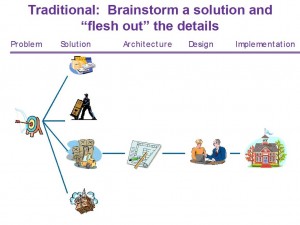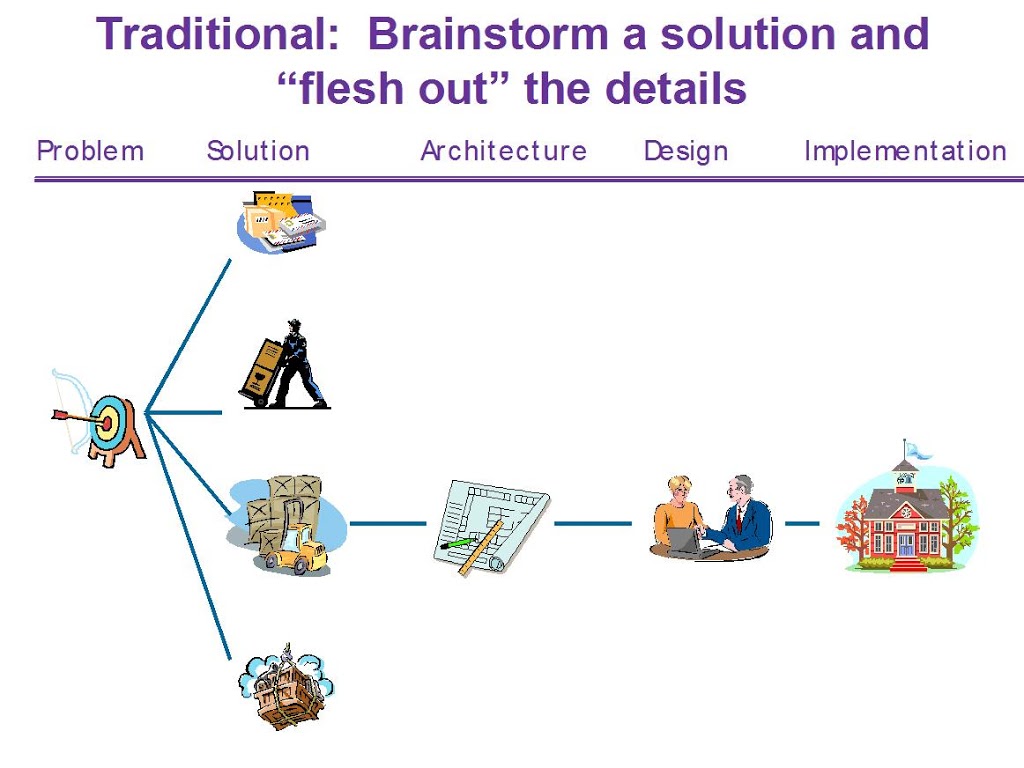Are you a divergent or convergent thinker? Divergent thinking is when you generate a lot of possibilities for a given problem. Convergent thinking is whittling options down to a few manageable items. Many corporate cultures favor convergence. Convergence focuses people and ensures that things get done. That’s a good thing usually. However, it can sometimes result in glossing over new opportunities or alternatives. Worse yet it can sometimes lead to very efficient and effective execution of the wrong things. Convergence and divergence are both important. By constantly iterating between the two, you can increase your levels of innovation and ensure that you are getting things done.
 Cycling through divergence and convergence
Cycling through divergence and convergence
When people hear “divergence”, they often think of brainstorming. Brainstorming is only one way to diverge (and a relatively poor way according to many innovation experts). Often if brainstorming happens at all, it happens once at the beginning of a project. Once a solution is identified teams move straight into execution to “drive out” the details.
If the path you chose is the right one, this process will be very efficient. If the path you chose isn’t correct, you will likely find yourself back at the drawing board after a lot of wasted effort and energy. There is an alternative that lets you continually move forward while keeping your options open.
In a diverge/converge model at each step in the project you generate as many options as possible and then select the one (or two) that you want to tackle.
At each stage you wind up with an entirely new course of action and set of options. There are also a lot of options “left behind”. If the current option doesn’t work out, you’ve already thought through an alternative you can try.
The key to generating innovative solutions is volume. With innovation, one indicator of success is the number of ideas left behind, not just the quality of the one selected.
So how do you do it?
Provide time to diverge – most of us get anxious and uncomfortable when our meetings start to go off in many directions. A lot of anxiety comes from the fear that the meeting will never get “back on track”. Set aside specific time in your meeting to spend on diverging activities and time for converging activities. By knowing that you are working within a specific timeframe you can relax and fully engage.
Use divergence techniques and exercises – Don’t just “brainstorm”, it’s too open ended if you aren’t used to thinking that way. There are a lot of books written on creativity and innovation that will give you specific hints, techniques and exercises to do.
Force yourself to think differently – Set yourself (or your team) a goal for how many new ideas you have to come up with before moving on. It’s amazing how well this works.
Be sure to have clear criteria for what you are trying to accomplish – Before diverging, and especially before converging, it is important to have well defined criteria and goals for what you are trying to accomplish. Allow enough time for the group to become comfortable with the context and desired outcomes of your sessions.
Create a creative atmosphere – I know it may seem new-agey and fluffy, but your atmosphere will impact your ability to think creatively. When it’s time to let loose and generate, open up the environment as much as possible. If you are in the Chicago area, book a conference room at Catalyst Ranch!
Resist the temptation to jump to a solution – Often our first instinct is the most obvious, overused or unoriginal option. Sometimes, obvious, overused and unoriginal ideas are the right answer. Just make sure that you’ve tested your options before coming to that conclusion.


